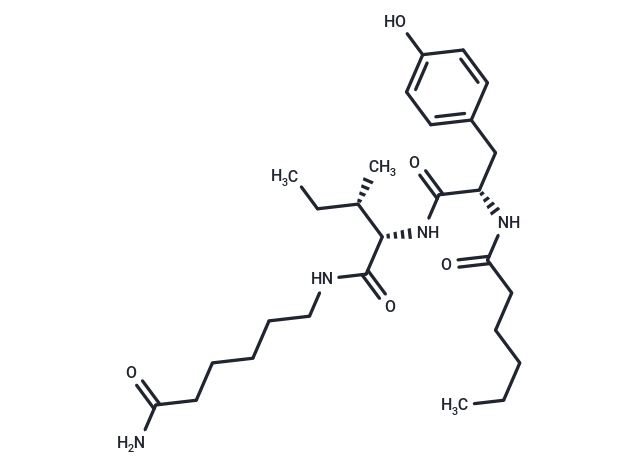Shopping Cart
- Remove All
 Your shopping cart is currently empty
Your shopping cart is currently empty

Dihexa (Hexanoyl-Tyr-Ile-Ahx-NH2) is an activator of the hepatocyte growth factor/c-Met (HGF/c-Met) system,it binds to HGF (Kd = 65 pM),and an analog of the peptide angiotensin IV.

| Pack Size | Price | Availability | Quantity |
|---|---|---|---|
| 1 mg | $63 | In Stock | |
| 5 mg | $135 | In Stock | |
| 10 mg | $229 | In Stock | |
| 25 mg | $397 | In Stock | |
| 50 mg | $579 | In Stock | |
| 100 mg | $818 | In Stock | |
| 1 mL x 10 mM (in DMSO) | $163 | In Stock |
| Description | Dihexa (Hexanoyl-Tyr-Ile-Ahx-NH2) is an activator of the hepatocyte growth factor/c-Met (HGF/c-Met) system,it binds to HGF (Kd = 65 pM),and an analog of the peptide angiotensin IV. |
| Targets&IC50 | HGF:65 pM(kd) |
| In vivo | Dihexa (2 mg/kg, i.p.) completely reverses scopolamine-induced learning deficits in the latency to find the platform and increases the time spent in the target quadrant in the Morris water maze in rats[1] |
| Alias | PNB-0408, N-hexanoic-Try-Ile-(6)-amino hexanoic amide, Hexanoyl-Tyr-Ile-Ahx-NH2 |
| Molecular Weight | 504.66 |
| Formula | C27H44N4O5 |
| Cas No. | 1401708-83-5 |
| Smiles | [C@H](CC1=CC=C(O)C=C1)(C(N[C@H](C(NCCCCCC(N)=O)=O)[C@H](CC)C)=O)NC(CCCCC)=O |
| Relative Density. | 1.111 g/cm3 (Predicted) |
| Storage | keep away from moisture | Powder: -20°C for 3 years | In solvent: -80°C for 1 year | Shipping with blue ice. | ||||||||||||||||||||||||||||||
| Solubility Information | DMSO: 30 mg/mL (59.45 mM) | ||||||||||||||||||||||||||||||
Solution Preparation Table | |||||||||||||||||||||||||||||||
DMSO
| |||||||||||||||||||||||||||||||

Copyright © 2015-2024 TargetMol Chemicals Inc. All Rights Reserved.